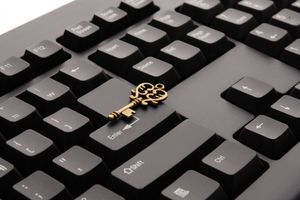I don't know about you, but whenever I finish one of my cold emails, I wonder if there’s a better way to end it besides: "Looking forward to hearing from you."
I mean, it's safe, it's polite – but let's face it, it's a bit of a cliché. It doesn't have to be that way. In this article, I will give you 10 better ways to end your emails so you can stand out from the rest of the crowd.
What Does "Looking Forward to Hearing From You" Mean Anyway?
Whether it's a job application, a sales email or even just reaching out to a friend, and when you’re at the end, you resort to: "Looking forward to hearing from you."
It's like a default ending, a way to wrap things up on a polite note, much like “Best regards.” But what does it really mean?
Well, in essence, it's a way of expressing eagerness for a response. It's like saying, "I've put my thoughts out there, and I'm genuinely interested in what you have to say."
Unfortunately, it's been used so frequently that its impact has faded. It's akin to a friend who says "I'm fine" with a distant look in their eyes – you're left wondering if they truly mean it.
So, why do people keep using it? There are a few reasons.
- It's safe. It's a universally accepted way to end an email without coming across as overly pushy or demanding.
- It's straightforward and neutral, which can work in professional settings where you want to maintain a level of formality.
However, like any overused phrase, it's lost its authentic touch. It's become the email equivalent of elevator music – there, but not really adding anything meaningful.
So it makes sense you’d want to do something different so every part of your email has an impact – from start to finish.
10 “Looking Forward to Hearing from You” Alternatives
Next time you get to the close of your email, try one of these better ways to end things:
1. I'd Love to Hear Your Thoughts
"I'd love to hear your thoughts" is a great way to close that not only conveys enthusiasm for a response but also opens up a welcoming space for further discussion.
It really shines when you need feedback, opinions or insights from the recipient. It's particularly effective if you've introduced a topic or idea earlier in the email and now you're genuinely interested in their perspective.
By using this ending, you demonstrate that you value their input and that you're genuinely interested in what they have to say. The friendly and positive tone helps alleviate any pressure on the recipient, making them more comfortable in sharing their thoughts.
2. Keep Me Up to Date / Keep Me Posted as Alternatives to Looking Forward to Hearing from You
Here’s a 2-for-1 – “Keep me up to date" or "Keep me posted" are excellent alternatives to the traditional closing. They indicate that you're not just interested in a one-time response, but you're invested in ongoing updates and developments.
They’re great in scenarios where you're collaborating with someone on a project, discussing a dynamic situation or dealing with a topic that's likely to evolve.
Like if you're working on a team project and you want to stay in the loop without overwhelming your colleagues. This ending shows you're engaged, willing to follow the progress and respectful of their time.
Furthermore, it's great for nurturing professional relationships because it implies a certain level of trust and open communication. It's a way of saying, "I value your insights, and I'm interested in staying connected as things grow and evolve."
And if you’re on friendly terms, “Keep me in the loop” also works fine.
3. Write Back Soon!
"Write back soon!" is perfect for those casual or friendly interactions where you're looking to maintain a lighthearted tone. It's an invitation to continue the conversation and indicates that you're genuinely looking forward to their response.
Think of it as the digital version of a friendly wave and a smile. It's suitable for catching up with friends, reaching out to colleagues you have a comfortable rapport with or reconnecting with someone after a while.
Unlike some more formal options, "Write back soon!" embraces informality and reflects a sense of immediacy.
4. Use a CTA
While "Looking forward to hearing from you" is general, a CTA allows you to guide the next steps of the conversation.
For instance, you could suggest meeting up for a coffee, discussing a potential collaboration or even setting up a phone call. This adds a layer of purpose to your email, indicating that you're not just looking for a reply but for a specific action.
Here are a few examples of CTAs you can use:
- "Let's have lunch on [date/time]."
- "I'd love to chat more about this. Can we schedule a call?"
- "If this resonates with you, feel free to share your thoughts."
- "Would you be interested in exploring this opportunity further?"
- "Give me a call at [phone number] if you'd like to discuss this in more detail."
CTAs are great when you want to take charge of the next steps and make your intentions crystal clear.
5. Can You Connect Me with the Right Person?
I like to use this phrase in settings where networking and connections matter. Like when you're looking for referrals, introductions or guidance on a specific matter.
And it works phenomenally if you’re trying to move up the food chain to one of the decision-makers at one of your prospect companies.
So whether you're exploring potential business opportunities, seeking advice on a particular industry or looking to expand your professional circle, "Can you connect me with the right person?" or something similar is a simple but powerful way to get connections you might otherwise miss.
6. If I Don’t Hear Back…
OK, it might sound like an ultimatum because that's pretty much what it is.
"If I don't hear back..." is a straightforward way to introduce a sense of urgency and clarity into your email conversations – especially when you're dealing with time-sensitive matters or awaiting a response that's critical to the next steps.
Using this lets you set expectations and define a clear timeline for a response. It's not about applying pressure, but rather about ensuring that both parties are on the same page.
Here are a few examples of how you can use this phrase:
- "If I don't hear back by [date], I'll assume we're moving forward with the current plan."
- “If I don’t hear back by Monday, I’ll assume you’re no longer interested.”
- "I'm looking forward to your input. If I don't receive your feedback by [date], I'll proceed based on the information we have.”
Just remember, while it might sound assertive, it's ultimately about efficiency and making sure things progress smoothly.
7. My Inbox Is Always Open
For internal comms, "My inbox is always open" shows you’re approachable and ready to engage in conversation.
You're essentially letting the recipient know that they're not just another email in your queue – you're genuinely interested in what they have to say, and you're available for discussions, questions or brainstorming.
(It’s the friendly equivalent of “Hope you’re doing well” for email openers.)
This alternative to “Looking forward to hearing from you” shines in environments where collaboration and open communication are valued. It's an invitation for others to reach out without hesitation, knowing that their input and ideas are valued.
8. I'd Appreciate Your Prompt Reply
"I'd appreciate your prompt reply" is a friendly nudge that gently encourages a timely response. It balances politeness with a subtle sense of urgency, making it suitable when you're looking to expedite the communication process.
You're conveying that while you value their time and input, there's also a certain level of time sensitivity involved.
This alternative works well in scenarios where efficiency is key – perhaps you're coordinating a time-sensitive project, trying to finalize plans or simply aiming to keep the momentum of the conversation going.
Remember, the goal here is not to rush the recipient but to maintain the pace of communication that aligns with the context.
9. Please Let Me Know if You Have Any Questions
"Please let me know if you have any questions" is a versatile ending, particularly when starting off the sales process. It shows your willingness to provide further information and support, creating an open channel for inquiries.
When you're reaching out to potential clients or customers, it's an invitation for them to seek clarification, express concerns or gather more details before making a decision.
Using this phrase at the end of a sales-oriented email conveys that you're not just focused on closing a deal, but you genuinely care about providing value and ensuring that the recipient has all the information they require.
10. Let Me Know if This Sounds Good
"Let me know if this sounds good" is another way to close out sales-oriented emails, presenting your proposal or offer in a friendly and inviting manner. This phrase opens the door for a response while also signaling your readiness to proceed with the next steps.
Here are a few examples of how you might use this phrase:
- "If this sounds good, we can move forward with the next steps."
- "Let me know if this resonates with your needs, and we can discuss the details further."
- "If this proposal aligns with your goals, I'm excited to explore how we can make it a reality."
- "If this offer piques your interest, I'd be more than happy to provide additional information."
By using this, you're prompting them to provide feedback and express their level of interest. It's a courteous way to gauge their response without applying excessive pressure.
Best Practices for Ending an Email
Let's explore some best practices to keep in mind while choosing your email ending.
1. Test Out Different Endings
Just like how you experiment with subject lines to optimize open rates, testing out different email endings can yield valuable insights. Not all recipients are the same, and what resonates with one person might not with another. Utilize A/B testing to determine which closing phrase garners better responses.
2. Keep The Tone Consistent
Your email's tone, whether it's formal, casual, or somewhere in between, should remain consistent throughout the message, including the closing. If you've maintained a friendly tone in your email, suddenly ending with a formal phrase might seem incongruent. Consistency in tone helps create a cohesive and genuine impression.
3. Don't Be Afraid to Be Creative
While the alternatives mentioned in this article provide fresh options, don't limit yourself to them. Injecting your personality and creativity into your email endings can set you apart and make your messages more memorable. If you have a signature phrase or a unique way of signing off, go for it. You might even consider an emoji or two for a more casual audience!
4. Personalize When Possible
Whenever you can, add a personal touch to your email ending. Mention a shared interest, reflect on a past interaction, or offer a specific gesture that shows you've considered the recipient's needs or preferences. Personalization goes a long way in making your communication feel genuine and relevant.
Elevate Your Email Endings
A well-crafted ending can influence responses, steer collaborations, and even establish a sense of connection that goes beyond words on a screen.
Think about it – those last few words can create intrigue, encourage action, or convey your openness to a continued dialogue. They're the final touch that leaves a lingering impression, making your message more than just another note lost in a sea of digital correspondence.
If you really want to take your email game to the next level, don’t forget about Findymail. After all, crafting a compelling ending is only half the battle; ensuring your emails reach the right destination is equally crucial.
With Findymail, you can supercharge your lead list with real, verified and valid email addresses.
Start with an engaging ending and let it lead you to lasting relationships!







